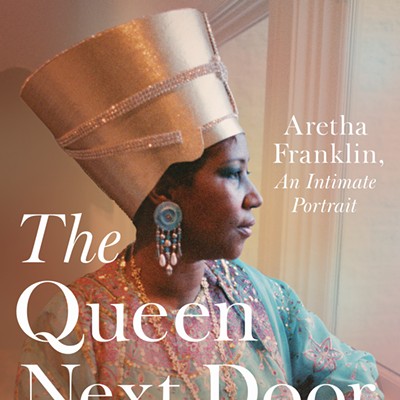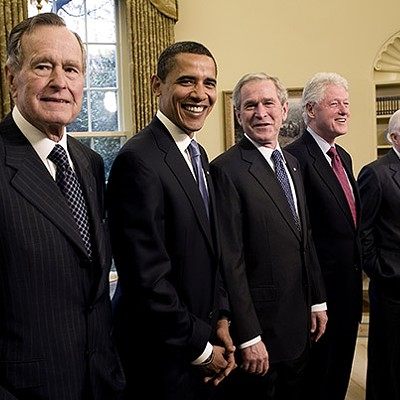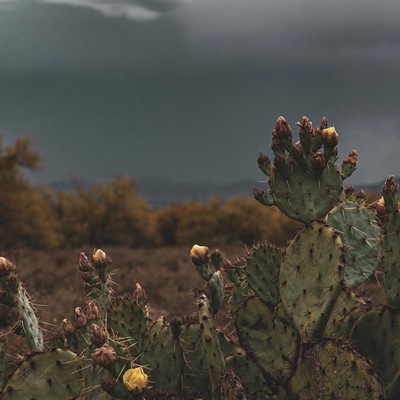With 87 dealers from all over the United States, a scattering from Europe, and a movie star-studded crowd (Viggo Mortenson from Lord of the Rings and Amanda Peet of Something's Gotta Give moved glitteringly among the booths), ultra-hip Photo LA is the major annual photo exhibition in the West. Notwithstanding today's frantic consumer rush to go digital, a development that triggered the Kodak announcement, Photo LA, if anything, celebrated old-time photography.
Consider the case of Tucson's Terry Etherton. Within minutes of the show's opening on Jan. 15, Etherton, Arizona's leading dealer of photography, sold two pictures dating back to the infancy of American photography. Both works were by Timothy O'Sullivan, the 19th-century photographer who practically invented western (and Arizona) photography. (See "The Life of Timothy O'Sullivan," March 13, 2003.) O'Sullivan's pioneering image of an inscription by Spanish explorers went to a private collector, and his view of a saguaro, the great-great-grandpappy of today's ubiquitous cactus photographs, turned right around and went back to the Old Pueblo.
"We bought the saguaro from Terry Etherton," Doug Nickel, the new director of the Center for Creative Photography, confirmed after he arrived back home. The Center already owns an album of O'Sullivan prints from the Wheeler expedition and a few loose prints, and Nickel wanted to bolster that modest collection. Back at his last job, at San Francisco Museum of Modern Art, Nickel put together a book and exhibition on Carleton Watkins, another 19th-century western photographer, and he's considering a major O'Sullivan show at the CCP down the road.
O'Sullivan (1840-1882) wasn't the only classic photog attracting buyers. A pair of well-heeled collectors were lustily eyeing the work of the French photographer Andreas Feininger (1906-1999) at the booth belonging to Los Angeles' Apex Fine Art Gallery; Feininger's famous 1955 black-and-white close-up of a photojournalist behind his camera was for sale, priced at $15,000 and $50,000 at different booths. A man roaming the Santa Monica Civic Auditorium boasted of the Garry Winogrand (1928-1984) tucked under his arm. Another couple put down $3,000 for the now-famous National Geographic portrait of the green-eyed Afghan girl by the still-living photojournalist Steve McCurry.
"Business clearly was better than last year," Etherton said. "In the past, a lot of people who might have taken three or four days to decide made quicker decisions this year. A lot of it was dealer-to-dealer business, but there were a lot of pictures leaving the room. There's been enough time between now and Sept. 11. It's picked up a bit."
As the dead white Old Masters were the show's star attractions, many cutting-edge contemporary photographers harkened back to old-timey processes, jazzed up by postmodern content. The husband-and-wife team Robert and Shana ParkeHarrison of Massachusetts, ages 36 and 40, were showing eerily beautiful photogravures at Bonni Benrubi, a New York gallery. Alluring with the soft charcoal tones and texture of the antique technique, their pictures nevertheless have a rogue surrealism.
"Reclamation," a take-off on old-fashioned genre painting and early pictorialist photography, pictures a man in a modern-day suit. At first, he appears to be working in the surf, like a fisherman in a Homer Winslow watercolor or in an early Alfred Stieglitz. But on closer inspection, he's pulling, not on the ocean's waves, but on man-made turf. It's like a roll of carpet, unfurled to look like undulating waves.
Commenting on a tendency to seek out long-abandoned techniques, Nickel said, "Creative anachronism was going strong. In some way, it's a reflection of greater interest in the history of photography generally."
Matthew Pillsbury, another current photographer, uses double exposures to destabilize the cozy scenes depicted in his otherwise classic black and whites. Also shown at Benrubi, his pictures are architectural interiors of contemporary New York lofts by night, their secure domestic spaces lit up by the city's 24-hour street lamps and signs. But each of them also has a glowing television inside, this modern-day hearth giving the pictures their names--"Philippa Ricopoulos and George, Law & Order," for instance. Pillsbury's manipulated the pictures to create ghostly images of the people entranced by the TV's programs. Like hard-to-see phantoms, a couple, barely there, lies in bed watching the crime show.
Loretta Lux, a German painter, was one of the few combining media. Her lustrous colored pictures of children are like fairy tales, of the grimly Grimm variety. (One is reproduced in the New Yorker of Jan. 26.) Nearly all the kids have big eyes and big heads, some of them crowned by strange braids, and they're wearing lime and pink clothes straight out of the 1970s. The children are set in fantasy landscapes, or in rough rooms, huts, perhaps, with plank floors; one girl holds a fish in her arms. At nearly $4,000 apiece, they were selling briskly. Lux's dealer, Yossi Milo Gallery in New York, explained to flocks of inquiring fans that Lux paints parts of the pictures, and then mixes her media by photographing the sets and the live children together. Part of the pictures' appeal is their mysterious confounding of reality.
Nickel, who led a collecting seminar at the exhibition, said he thinks that quality of unreality, or untruth, is partly what has people so uneasy about digital. Once upon a time, everyone believed in the truth of photography, but nowadays, people readily acknowledge that photography is an art of artifice as much as painting is. Photography has always had the capacity to bend the truth, Nickel said, but people fear the power of Photoshop even more.
"There's a natural anxiety around it," he said. "Nobody knows what it means." Still, he added, "I didn't see a lot of digital work in evidence."
Nevertheless, the digital upstart seemed to be on the hearts and minds of photographers in attendance. Lectures by leading photographers, particularly those with a new book out, are on the agenda each year, and at the three lectures on Saturday, every single speaker was asked afterward in a Q&A whether he or she uses digital. The answer in each case was no, though at least one is curious about trying it.
Lynn Geesaman, a Minneapolis photographer whose new Aperture book Gardenscapes includes several dreamy color images of Arizona's Chiricahua Mountains, said cheerfully, "I don't use digital but I would like to learn how to do some of that."
Sally Gall, a New Yorker whose touring exhibition of ethereal black-and-white cave photos is now showing at Etherton in Tucson (her book is Subterranea), echoed Geesaman: "I've never done digital. I don't have a reason to go there right now."
But the best answer came from Harry Benson, a genial elderly photojournalist originally from Glasgow. The white-haired Benson enthralled the audience with his tales of covering the Beatles for a London paper (his new volume of moptop pix is Once There Was a Way), of dodging tear gas and fisticuffs in Mississippi during civil rights days, of watching Robert F. Kennedy crumple to the hotel floor. Proud of his photographs of every president since Eisenhower, including the incumbent, he spluttered when he got the inevitable digital question.
"I can't work the digital camera!" he growled. But he added that he doesn't see that it matters so much. It's the imagination that counts, he said.
"It's not the equipment. It's putting the camera where it's never been before."














